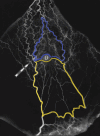The Anatomic Features and Role of Superficial Inferior Epigastric Vein in Abdominal Flap
- PMID: 35919553
- PMCID: PMC9340173
- DOI: 10.1055/s-0042-1748645
The Anatomic Features and Role of Superficial Inferior Epigastric Vein in Abdominal Flap
Abstract
In lower abdominal flap representing transverse rectus abdominis musculocutaneous (TRAM) flap or deep inferior epigastric perforator (DIEP) flap, superficial inferior epigastric vein (SIEV) exists as superficial and independent venous system from deep system. The superficial venous drainage is dominant despite a dominant deep arterial supply in anterior abdominal wall. As TRAM or DIEP flaps began to be widely used for breast reconstruction, venous congestion issue has been arisen. Many clinical series in regard to venous congestion despite patent microvascular anastomosis site were reported. Venous congestion could be divided in two conditions by the area of venous congestion and each condition is from different anatomical causes. First, if venous congestion was shown in whole flap, it is due to the connection between SIEV and vena comitantes of DIEP. Second, if venous congestion is limited in above midline (Hartrampf zone II), it is due to problem in venous midline crossover. In this article, the authors reviewed the role of SIEV in lower abdominal flap based on the various anatomic and clinical studies. The contents are mainly categorized into four main issues; basic anatomy of SIEV, the two cause of venous congestion, connection between SIEV and vena comitantes of DIEP, and midline crossover of SIEV.
Keywords: deep inferior epigastric perforator flap; superficial inferior epigastric vein; transverse rectus abdominis musculocutaneous flap; venous congestion.
The Korean Society of Plastic and Reconstructive Surgeons. This is an open access article published by Thieme under the terms of the Creative Commons Attribution-NonDerivative-NonCommercial License, permitting copying and reproduction so long as the original work is given appropriate credit. Contents may not be used for commercial purposes, or adapted, remixed, transformed or built upon. ( https://creativecommons.org/licenses/by-nc-nd/4.0/ ).
Conflict of interest statement
Conflict of Interest H.C. is an editorial board member of the journal but was not involved in the peer reviewer selection, evaluation, or decision process of this article. No other potential conflicts of interest relevant to this article were reported.
Figures





Similar articles
-
Selection of the recipient veins for additional anastomosis of the superficial inferior epigastric vein in breast reconstruction with free transverse rectus abdominis musculocutaneous or deep inferior epigastric artery perforator flaps.Ann Plast Surg. 2011 Nov;67(5):505-9. doi: 10.1097/SAP.0b013e31820bcd5f. Ann Plast Surg. 2011. PMID: 21407052
-
A quantitative analysis of the venous outflow of the deep inferior epigastric flap (DIEP) based on the perforator veins and the efficiency of superficial inferior epigastric vein (SIEV) supercharging.J Plast Reconstr Aesthet Surg. 2013 Jan;66(1):67-72. doi: 10.1016/j.bjps.2012.08.020. Epub 2012 Sep 13. J Plast Reconstr Aesthet Surg. 2013. PMID: 22981386
-
Strategies for recognizing and managing intraoperative venous congestion in abdominally based autologous breast reconstruction.Plast Reconstr Surg. 2012 Apr;129(4):809-815. doi: 10.1097/PRS.0b013e318244222d. Plast Reconstr Surg. 2012. PMID: 22456352
-
Intraoperative venous congestion in free transverse rectus abdominis musculocutaneous and deep inferior epigastric artery perforator flaps during breast reconstruction: A systematic review.Plast Surg (Oakv). 2015 Winter;23(4):255-9. Plast Surg (Oakv). 2015. PMID: 26665142 Free PMC article. Review.
-
Intraoperative superficial inferior epigastric vein preservation for venous compromise prevention in breast reconstruction by deep inferior epigastric perforator flap.Ann Chir Plast Esthet. 2019 Jun;64(3):245-250. doi: 10.1016/j.anplas.2018.09.004. Epub 2018 Oct 13. Ann Chir Plast Esthet. 2019. PMID: 30327210 Review.
Cited by
-
Microsurgical breast reconstruction in the United States: a narrative review of the current state.Gland Surg. 2024 Aug 31;13(8):1535-1551. doi: 10.21037/gs-24-63. Epub 2024 Aug 20. Gland Surg. 2024. PMID: 39282034 Free PMC article. Review.
-
Use of the superficial inferior epigastric vein in breast reconstruction with a deep inferior epigastric artery perforator flap.Front Surg. 2023 May 22;10:1050172. doi: 10.3389/fsurg.2023.1050172. eCollection 2023. Front Surg. 2023. PMID: 37284559 Free PMC article.
References
-
- Taylor G I, Daniel R K. The anatomy of several free flap donor sites. Plast Reconstr Surg. 1975;56(03):243–253. - PubMed
-
- Carramenha e Costa M A, Carriquiry C, Vasconez L O, Grotting J C, Herrera R H, Windle B H. An anatomic study of the venous drainage of the transverse rectus abdominis musculocutaneous flap. Plast Reconstr Surg. 1987;79(02):208–217. - PubMed
-
- Rozen W M, Pan W R, Le Roux C M, Taylor G I, Ashton M W. The venous anatomy of the anterior abdominal wall: an anatomical and clinical study. Plast Reconstr Surg. 2009;124(03):848–853. - PubMed
-
- Schaverien M, Saint-Cyr M, Arbique G, Brown S A. Arterial and venous anatomies of the deep inferior epigastric perforator and superficial inferior epigastric artery flaps. Plast Reconstr Surg. 2008;121(06):1909–1919. - PubMed
-
- Kita Y, Fukunaga Y, Arikawa M, Kagaya Y, Miyamoto S. Anatomy of the arterial and venous systems of the superficial inferior epigastric artery flap: a retrospective study based on computed tomographic angiography. J Plast Reconstr Aesthet Surg. 2020;73(05):870–875. - PubMed
LinkOut - more resources
Full Text Sources
Research Materials

